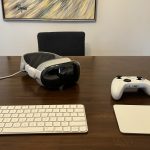A report by tech news site The Information suggests that Apple is shifting its augmented reality priorities. The next high-end version of the Vision Pro has purportedly been canceled while work continues on a more affordable version with a reduced feature set.
Citing both an employee in Apple's headset supply chain and one working in headset manufacturing for Apple, the report claims that the cheaper Vision product—perhaps around the $1,600 mark—is due before the end of 2025. Apple had originally intended to present this headset alongside the Vision Pro, similar to the models available in each iPhone release. The more affordable model would likely have fewer cameras, smaller speakers, and weigh less, though Apple has struggled to bring down the cost of the unit's displays.
Apple's efforts in augmented reality are closely watched by other players in the headset space, so even a momentary, situational step back from high-end headsets could have significant repercussions. The Information cites current and former Meta employees in describing how the company had killed plans for its own higher-end headset in January 2023, but it then began work on a new premium model five months after Apple's Vision Pro debut.



 Loading comments...
Loading comments...
